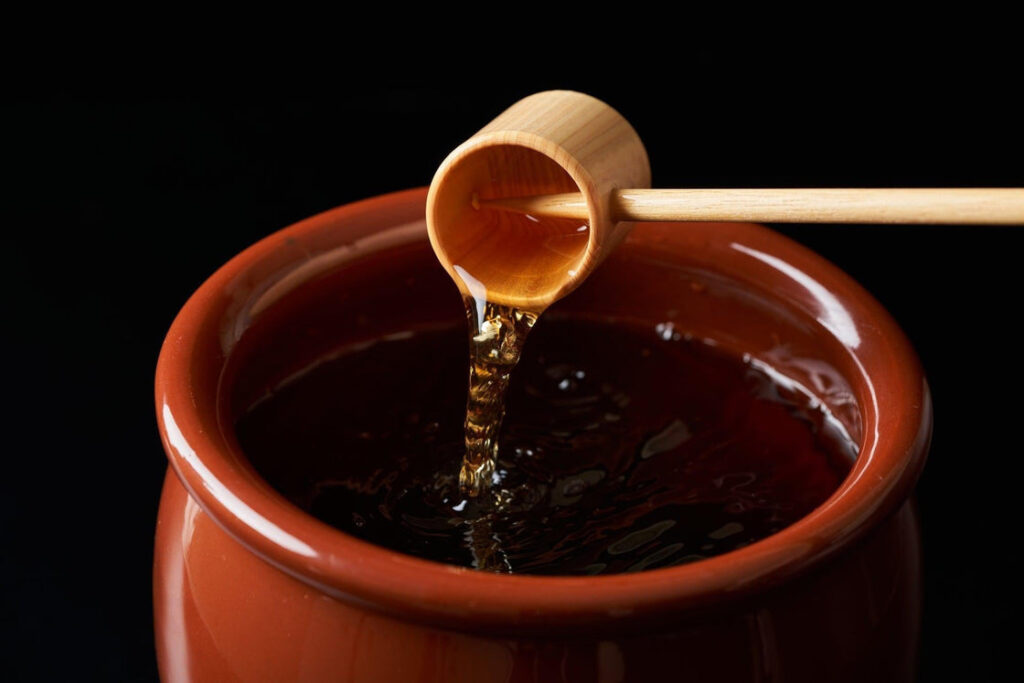Japan is not only renowned for its rich history and stunning natural landscapes but also for its unparalleled culinary traditions. Among the plethora of culinary delights that Japan is celebrated for, black vinegar holds a special place. This unique and flavorful condiment has been a staple in Japanese cuisine for centuries, prized for its distinct taste and numerous health benefits.
 Pin
Pin Image from saveur
Table of Contents
Black Vinegar: Introduction
Black vinegar, also known as kurozu in Japanese, is made through a meticulous fermentation process that dates back to ancient times. The key ingredients for making black vinegar include glutinous rice, water, and a special type of fermentation starter called koji. The mixture is carefully fermented and aged in wooden barrels for an extended period, allowing the flavors to develop and deepen over time.
One of the most famous regions in Japan known for its exceptional black vinegar production is the city of Kagoshima in Kyushu. Here, skilled artisans meticulously follow traditional methods handed down through generations to create the finest black vinegar. The unique climate and mineral-rich water in Kagoshima contribute to the distinct flavor profile of the vinegar, making it a sought-after delicacy both locally and internationally.
The art of making black vinegar goes beyond just the fermentation process; it embodies a deep-rooted cultural heritage and a profound respect for quality and tradition. Each batch of black vinegar is carefully monitored and nurtured, with artisans using their expertise to ensure that the final product meets the highest standards of excellence.
From its rich umami flavor to its potential health benefits, including aiding digestion and promoting overall well-being, black vinegar holds a special place in Japanese cuisine and culture. Whether used in dressings, marinades, or sauces, black vinegar adds a unique depth of flavor that elevates any dish it touches.
The History of Kurozu
Black vinegar, or kurozu, is a cornerstone of Japanese culinary tradition, boasting a history as rich and complex as its flavor profile. While its origins are shrouded in the mists of time, its documented journey begins during the Edo period, a time of significant cultural and economic growth in Japan.
Accidental Discovery: Kurozu’s Humble Beginnings
Interestingly, kurozu’s existence owes much to serendipity. The Edo period was a golden age for sake brewing, a process that involves fermenting rice. In the pursuit of perfecting this beloved beverage, brewers often encountered a byproduct: a dark, acidic liquid that formed during the brewing process. Initially seen as a waste product, this liquid was gradually recognized for its unique taste and potential uses beyond the sake-making process.
Byproduct to Beloved Ingredient
As the Edo period progressed, the Japanese developed a keen appreciation for the complex flavors that could be derived from fermented foods. The dark, acidic liquid from the sake breweries, with its tangy yet mellow character, began to capture the palate of the nation. Over time, it transitioned from a mere byproduct to a sought-after ingredient in its own right.
The Evolution of Kurozu Production
With growing demand, the production of kurozu evolved beyond the confines of sake breweries. Dedicated artisans began experimenting with different rice varieties, fermentation techniques, and aging processes to refine the flavor and quality of the vinegar. This experimentation led to the development of distinct regional styles of kurozu, each with its own unique characteristics.
The Art of Kurozu Making
The creation of black vinegar is a labor-intensive process that demands patience and expertise.
- Ingredient Selection: High-quality brown rice is the primary ingredient. The choice of rice variety significantly impacts the final flavor.
- Koji Fermentation: Koji, a type of mold, is introduced to the rice to initiate fermentation. This process converts starches into sugars, creating the foundation for vinegar production.
- Acetic Acid Bacteria: The mixture undergoes a second fermentation, where acetic acid bacteria convert the sugars into acetic acid, the main component of vinegar.
- Aging: The vinegar is aged in clay pots for several years, allowing the flavors to develop and deepen. This aging process is crucial for achieving the characteristic black color and rich taste.
The Flavor Profile of Kurozu
Unlike the sharp, acidic profile of many Western vinegars, kurozu offers a complex and harmonious blend of flavors. The most prominent notes are sweetness and acidity, which create a balanced and intriguing taste. However, the true magic lies in the presence of umami, a savory taste often described as a fifth taste sensation. This umami depth, derived from the long fermentation process, gives kurozu its unique character and ability to enhance the flavors of other ingredients. The result is a vinegar that is both refreshing and satisfying.
Kurozu's Colour
 Pin
Pin Image from japanesetaste
The deep, dark hue of kurozu is a hallmark of its quality and age. This rich color is a product of the extended aging process, during which complex chemical reactions occur, transforming the vinegar’s appearance. The longer the aging period, the darker the color tends to be. This visual characteristic, combined with the vinegar’s aromatic qualities, contributes to its overall appeal.
The Potential Health Benefits of Kurozu
Beyond its culinary prowess, kurozu has garnered attention for its potential health benefits. Rich in amino acids, essential building blocks of protein, it provides a nutritional boost. Additionally, kurozu contains minerals essential for overall well-being. Traditional Japanese culture has long attributed various health benefits to kurozu, including improved digestion, enhanced blood circulation, and potential antioxidant effects. While scientific research on these claims is ongoing, the vinegar’s nutritional profile certainly supports its reputation as a healthful condiment.
Kurozu in Modern Cuisine
 Pin
Pin Image from nishikidori
Kurozu, more commonly known as black vinegar, has found its place in modern cuisine outside its traditional use in Japanese dishes like soba noodles and sushi. This tangy vinegar has captured the attention of chefs and home cooks globally due to its versatility and remarkable ability to elevate the flavors of a wide range of cuisines.
One of the reasons for its growing popularity is its unique ability to add depth and complexity to dishes. Whether it’s used in salad dressings to give a refreshing kick or in marinades to tenderize meats and infuse them with rich umami notes, black vinegar brings a distinctive flavor profile that sets dishes apart.
In salad dressings, black vinegar can create a perfect balance of sweetness and acidity, enhancing the overall taste of fresh vegetables and greens. The slight tanginess of the vinegar can uplift simple salads into gourmet creations, delighting the palate with each bite.
When used in marinades, black vinegar acts as a flavor enhancer, infusing meats with a savory, slightly sweet taste that complements a variety of seasonings and spices. It not only tenderizes the meat but also adds a depth of flavor that lingers on the taste buds, making each bite a culinary experience.
Beyond salads and marinades, black vinegar’s possibilities are endless. It can be drizzled over roasted vegetables for a burst of flavor, used as a dipping sauce for dumplings, or even incorporated into glazes for meats and seafood.
The beauty of black vinegar lies in its ability to seamlessly blend with different ingredients, enhancing the overall taste of a dish without overpowering other flavors. Its versatility makes it a valuable ingredient in modern cuisine, allowing chefs and home cooks to experiment with new flavor combinations and elevate their culinary creations to new heights.
As the culinary world continues to embrace global flavors and innovative techniques, black vinegar stands out as a timeless ingredient that brings a touch of sophistication and depth to dishes, making it a staple in kitchens around the world.
Conclusion
Japan’s black vinegar highlights the country’s dedication to preserving traditional techniques. The meticulous process of creating kurozu results in a product that is both delicious and beneficial. As the world becomes increasingly interested in authentic flavors and sustainable food production, black vinegar is poised to become an even more celebrated ingredient on the global culinary stage.
FAQs about Kurozu (Black Vinegar)
Kurozu, or black vinegar, is a traditional Japanese vinegar known for its deep, rich flavor and complex taste profile. It’s made from fermented brown rice and is aged for several years, giving it its distinctive dark color and unique umami notes.
Kurozu has a long history in Japan, dating back to the Edo period. It was originally a byproduct of sake brewing but eventually became a prized ingredient in its own right. Over time, the production process was refined, and kurozu gained recognition for its culinary and potential health benefits.
Kurozu production is a time-consuming process. It involves several steps:
- Ingredient Selection: High-quality brown rice is used as the base.
- Koji Fermentation: Koji, a type of mold, is added to the rice to start the fermentation process, converting starches into sugars.
- Acetic Acid Bacteria: The mixture undergoes another fermentation with acetic acid bacteria, transforming sugars into acetic acid.
- Aging: The vinegar is aged in clay pots for several years, developing its rich flavor and dark color.
Kurozu has a complex flavor profile with notes of sweetness, acidity, and umami. It’s not as sharp as many Western vinegars and offers a more balanced taste.
While more research is needed, kurozu is believed to offer several potential health benefits due to its amino acid and mineral content. These may include improved digestion and blood circulation.
Kurozu is incredibly versatile. Traditionally used in Japanese dishes like soba and sushi, it’s now popular worldwide. You can use it in salad dressings, marinades, sauces, and even as a flavor enhancer in soups and stews.
Kurozu is becoming more widely available. You can find it in specialty food stores, Asian markets, and online retailers.




























